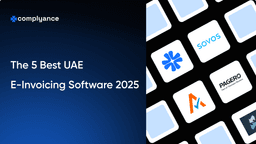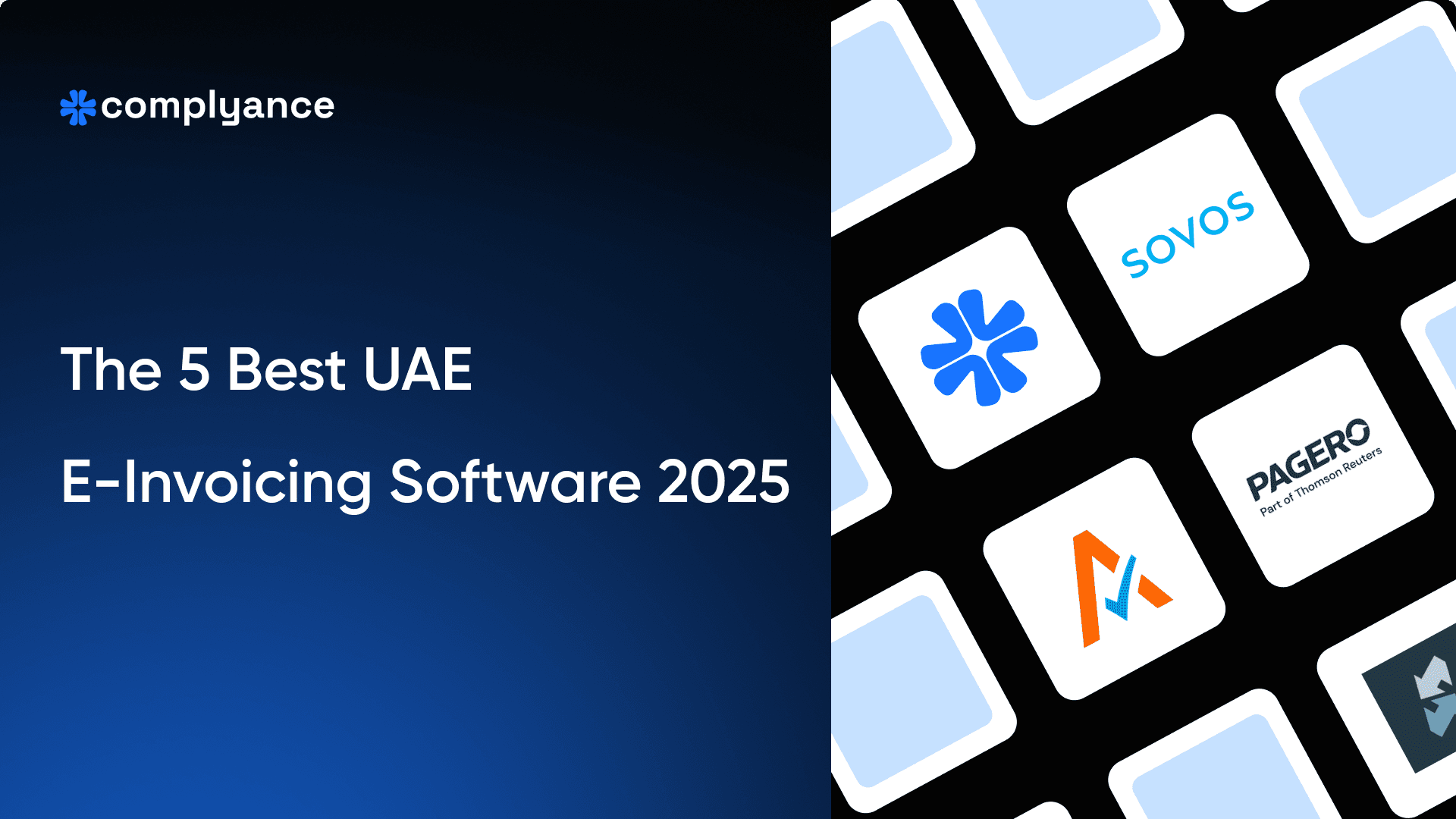How the Peppol CTC Model Works in UAE E-Invoicing
Understand the UAE’s Peppol CTC model and its Five-Corner framework. Learn how it enables real-time e-invoicing, secure data exchange, and full e-invoicing compliance with the Federal Tax Authority (FTA).

Table of Contents
The UAE e-invoicing system is changing how businesses send and receive invoices. The government wants all invoices to be digital, real-time, and secure. To make this happen, the UAE is using the Decentralized Continuous Transaction Control for E-Invoicing (DCTCE) framework, which is built upon the Peppol Continuous Transaction Control (CTC) model. This model helps the Federal Tax Authority (FTA) receive invoice data almost instantly while ensuring businesses stay e-invoicing compliant and operate smoothly. Let’s understand what this Peppol CTC model (DCTCE) means, how it works, and why it’s important for every business in the UAE.
What is the Peppol CTC Model?
The Peppol CTC model is a system that helps countries collect invoice data in real time. “CTC” means Continuous Transaction Control. This means the tax authority can see each transaction when it happens. Instead of checking invoices after they are sent, the system checks and stores them as they are created. In the UAE, this model connects businesses, service providers, and the tax authority platform using secure digital channels. So, when a business sends an e-invoice, it goes through trusted service providers called Peppol Access Points. These Access Points make sure invoices are in the right format and shared safely.
What is an E-Invoicing Framework?
An e-invoicing framework is like a rulebook for sending electronic invoices. It tells companies how to create, send, and check invoices, so they meet the government’s requirements. There are two main types of e-invoicing frameworks based on their structure and control mechanisms.
Decentralized E-Invoicing
In a decentralized e-invoicing system, control is shared between businesses, certified Access Points, and the tax authority—creating a model built on collaboration and flexibility rather than central enforcement. Multiple certified service providers handle invoice exchanges using global standards like Peppol BIS and Peppol PINT, allowing businesses to choose their preferred provider while staying compliant.
Invoices move securely between sender and receiver through these Access Points, and transaction data is simultaneously shared with the tax authority in real time. This approach eliminates the need for a single national gateway and supports cross-border interoperability and multi-system integrations.
Countries such as the UAE, Belgium, Singapore, and Australia use this Five-Corner structure, which ensures secure, real-time compliance without sacrificing operational flexibility.
Centralized E-Invoicing
In a centralized e-invoicing system, control rests entirely with the government, as every invoice must pass through a national platform before reaching the buyer. This setup enables full visibility and regulatory oversight but limits flexibility for global businesses using multiple ERP or billing systems.
It is best suited for domestic use, where a uniform process and strict validation are required. Countries like Italy (SDI), Poland (KSeF), France (PPF/PDP model), and Chile follow this centralized model to maintain tighter transaction control and ensure data consistency across all invoices.
Decentralized vs. Centralized E-Invoicing Models
| Aspect | Decentralized E-Invoicing | Centralized E-Invoicing |
|---|---|---|
| Structure | Many certified service providers exchange invoices using common standards like Peppol BIS or PINT. | All invoices pass through one national platform controlled by the government. |
| Control | Control is shared between businesses and certified Access Points, and the tax authority, offering more flexibility and collaboration. | Fully controlled by the government, which validates or stores every invoice. |
| Data Flow | Invoices are exchanged securely between sender and receiver through Access Points, while transaction data is simultaneously shared with the tax authority. | Every invoice is sent to the government platform first for validation or storage before reaching the receiver. |
| Flexibility | High. Supports cross-border and multi-system integrations. | Limited. Mainly suited for domestic transactions. |
| Example Countries | UAE, Belgium, Singapore, Australia | Italy, Poland, France, Chile |
How the Peppol CTC Framework Works in the UAE
The UAE’s Peppol CTC framework follows a Five-Corner Model, which evolved from the traditional Four-Corner Model used in countries like Belgium, Singapore, and Australia.While the Four-Corner Model connects the sender, receiver, and their respective access points, the UAE’s Five-Corner setup introduces the Federal Tax Authority (FTA) as an additional participant to meet the UAE’s Continuous Transaction Control (CTC) requirements.This structure ensures that every invoice is shared securely, follows all compliance rules, and remains visible to the tax authority without slowing down business operations.
Here’s how it works step by step:
- Supplier Generates the Invoice: The supplier creates an invoice in their ERP or billing system in a standard format (not yet an e-invoice).
- Supplier’s Accredited Service Provider (ASP) Validates and Converts: The supplier’s ASP checks the invoice against UAE requirements and converts it into the PINT-AE XML format. At this point, the invoice becomes a valid e-invoice.
- Service Metadata Publisher (SMP) Routes the Invoice: The SMP manages and publishes metadata about participants (supplier, buyer, ASPs) and their access points. This ensures that the e-invoice is routed to the correct destination and that all participants have the necessary information to process it.
- Transmission to Buyer’s ASP: Using the Peppol network and SMP data, the e-invoice is securely delivered to the buyer’s ASP.
- Buyer Receives and Processes the Invoice: The buyer’s ASP delivers the e-invoice to the buyer’s ERP/accounting system, where it can be accepted, reconciled, or processed further.
- Reporting to the Federal Tax Authority (FTA): Both ASPs generate the Tax Data Document (TDD) and send it to the FTA via the Central Data Platform (CDP).
- FTA Validates and Accepts the TDD: The FTA validates the TDD in real time. Once accepted, the invoice is officially recorded as compliant and audit-ready.
Explore our detailed guide on the 5-Corner Model for e-invoicing For a detailed, step-by-step explanation of the 5 Corner Model, sign up for a free UAE E-Invoicing consultation with one of our tax experts
Key Features of the Peppol CTC Model
Here are the main features that make the UAE’s Peppol CTC model strong and future-ready:
1. Decentralized but Secure Businesses connect through certified Peppol Access Points instead of sending everything to a single portal. This allows businesses to manage their invoicing process more flexibly while keeping all data secure.
2. Based on Global Standards The Peppol CTC model uses Peppol BIS (Business Interoperability Specifications) and Peppol PINT (Peppol International Invoice) formats. This means that invoices can be easily read by systems all over the world.
3. Government-Approved Access Points In the UAE, the Ministry of Finance (MoF) authorizes specific service providers called Peppol Access Points to handle the secure exchange and transmission of e-invoices between businesses.
4. Safe Transmission The system uses the AS4 protocol, a secure method for sending files. It ensures your invoice data cannot be stolen or changed during transfer.
5. Real-Time Reporting Each invoice is shared instantly with the UAE tax authority platform (FTA). This helps the government monitor tax compliance and prevent VAT fraud.
Benefits of the Peppol CTC Model for Businesses
The Peppol CTC model brings many benefits to businesses in the UAE:
A. Faster and Easier Processes No more manual data entry. Invoices are created and sent automatically from your system. This saves time and reduces human error.
B. Full Compliance All e-invoices go to the tax authority platform UAE automatically, keeping you e-invoicing compliant with VAT laws.
C. Better Transparency Every invoice can be tracked in real time. This helps with audits and reduces the risk of mistakes.
D. Works Across Borders Since Peppol is used worldwide, your system will also work smoothly for international invoices.
E. Strong Data Security Invoices are encrypted during transmission, keeping business data safe and GDPR-compliant.
Why the UAE Chose the Peppol CTC Model
The UAE adopted the Peppol Continuous Transaction Control (CTC) model, also known as the 5-corner model, to strike the right balance between real-time tax compliance, fraud prevention, and business automation. This approach also supports global interoperability and ensures long-term system resilience across industries.
1. Transparency and Fraud Control The CTC model enables the Federal Tax Authority (FTA) to access invoice data almost instantly through certified service providers. By receiving transaction details in real-time, the authority can identify irregularities and prevent VAT leakage or fraud far more effectively than traditional audit-based systems.
2. Global Interoperability and Standardization By adopting the Peppol framework and the Peppol International (PINT) standard, especially the localized PINT AE version, the UAE ensures that businesses can exchange invoices effortlessly with both local and international trading partners. This promotes consistent communication across systems and helps the UAE maintain its position as a global business hub, avoiding the fragmentation seen in country-specific solutions
3. Business Automation and Efficiency Since the Peppol CTC model is decentralized, businesses can easily send and receive invoices through trusted service providers approved by the government. This setup speeds up document exchange, reduces manual errors, and improves cash flow visibility, all without requiring companies to overhaul their existing ERP or billing systems.
4. Scalability and System Resilience By letting several certified providers handle invoice validation and exchange, the system avoids depending on just one platform that could cause problems if it fails. This modular structure makes the network more stable and easier to scale, allowing the UAE to roll out e-invoicing in phases while maintaining performance and uptime.
5. Inclusion for Small and Medium Enterprises (SMEs) The framework is designed with SMEs in mind, offering affordable or even free Access Points to encourage adoption. This ensures that smaller companies can transition to digital invoicing without heavy financial or technical barriers.
6. Alignment with National Vision This move supports the UAE’s broader digital transformation strategy and aligns with the “We the UAE 2031 Vision”, which aims to build a smart, paperless, and highly efficient economy. Through automation and transparency, the government seeks to optimize tax operations and minimize manual intervention.
How Businesses Can Prepare for UAE E-invoicing with complyance
Preparing early for the UAE’s peppol DCTCE model helps businesses go live smoothly and stay compliant from day one. Here are six simple steps to get started:
Conduct a Technical Assessment: Begin by evaluating your current billing software's capability to generate FTA-compliant invoices. Complyance's ASP solution integrates seamlessly with your existing systems, ensuring automatic generation of compliant XML files without requiring system replacements or major overhauls.
Streamline Data Management: Data accuracy is fundamental to successful implementation. Our platform includes automated validation tools that verify TRN authenticity and data completeness in real-time, significantly reducing errors before submission and ensuring smooth data transmission to the FTA.
Choose an Adaptive Technology Partner: As your dedicated ASP, Complyance provides more than just software; we offer a partnership built on continuous regulatory adaptation. Our cloud-based solution automatically updates to meet evolving FTA requirements, ensuring ongoing compliance without additional development costs or efforts.
Foster Cross-Team Alignment: Successful preparation requires organizational alignment. Complyance supports this through customized training programs and clear documentation tailored for finance, IT, and tax teams. We ensure that all stakeholders understand their roles within the new e-invoicing framework.
Implement Comprehensive Testing: Utilize Complyance's testing environment to simulate the complete invoice lifecycle, from creation to submission and exception handling. This sandbox environment allows you to identify and resolve issues before going live, ensuring a confident transition to the new system.
Establish Sustainable Processes: Complyance provides ongoing support and documentation to help formalize your e-invoicing workflows. We help you develop clear procedures for daily operations, error resolution, and e-invoicing compliance maintenance, ensuring long-term success beyond implementation.
Read our detailed guide: How to Prepare for UAE E-Invoicing in 6 Simple Steps
Conclusion
The Peppol CTC model represents a significant milestone in the UAE’s journey toward a fully digital, transparent, and efficient e-invoicing system. By combining real-time e-invoicing compliance, global Peppol standards, and decentralized data exchange, it helps businesses work faster, safer, and smarter. With Complyance, companies can simplify this transition. Integrating seamlessly with existing systems, automating e-invoicing compliance, and staying future-ready as e-invoicing evolves across the UAE and beyond.
Related posts
Subscribe to our Newsletter
Get the latest compliance updates, e-invoicing news, and expert tips delivered to your inbox.
ABOUT COMPLYANCE
Empowering businesses to automate e-invoicing and stay compliant in 100+ countries. Our platform simplifies regulatory complexity for enterprises and fast-growing companies.






